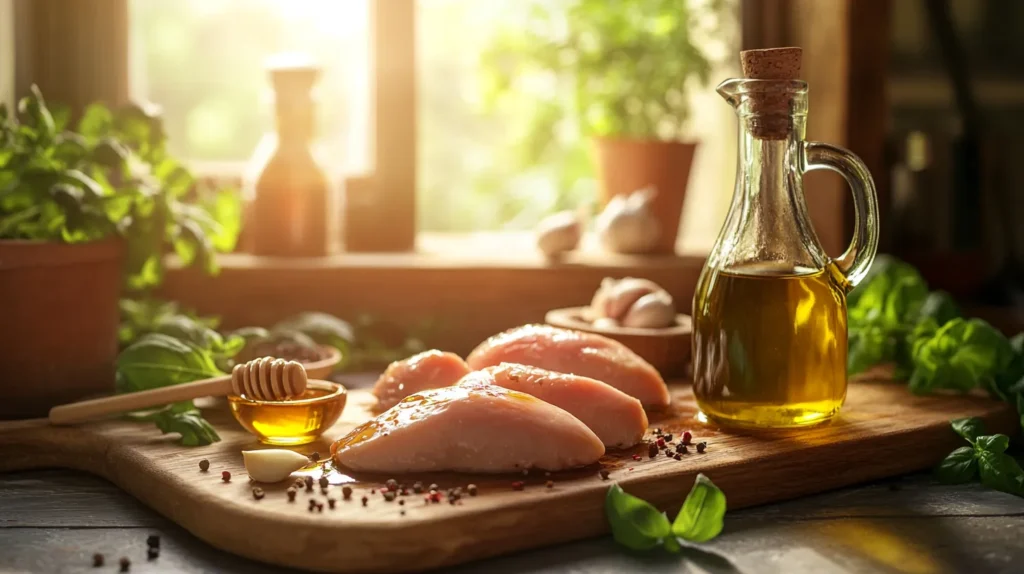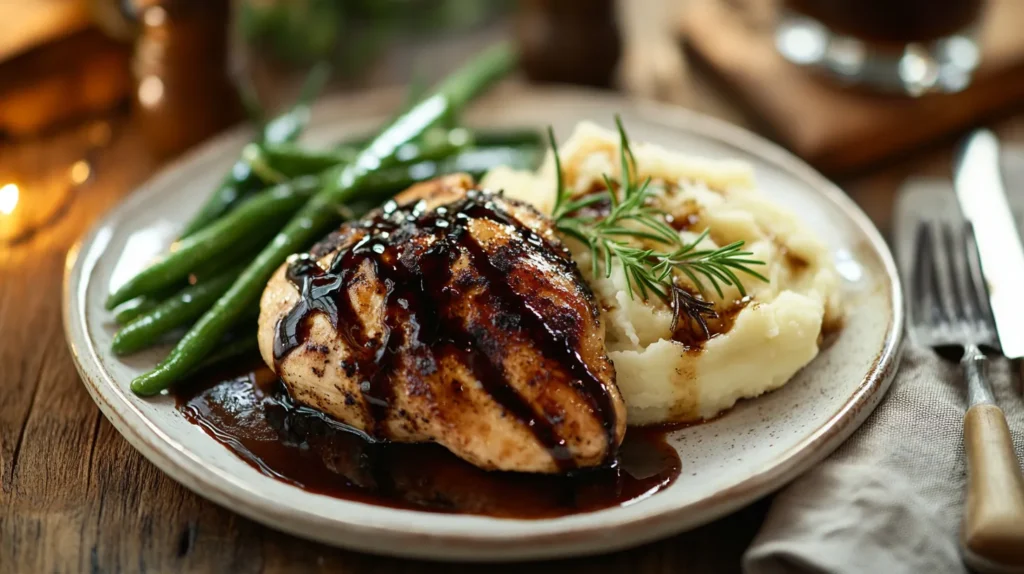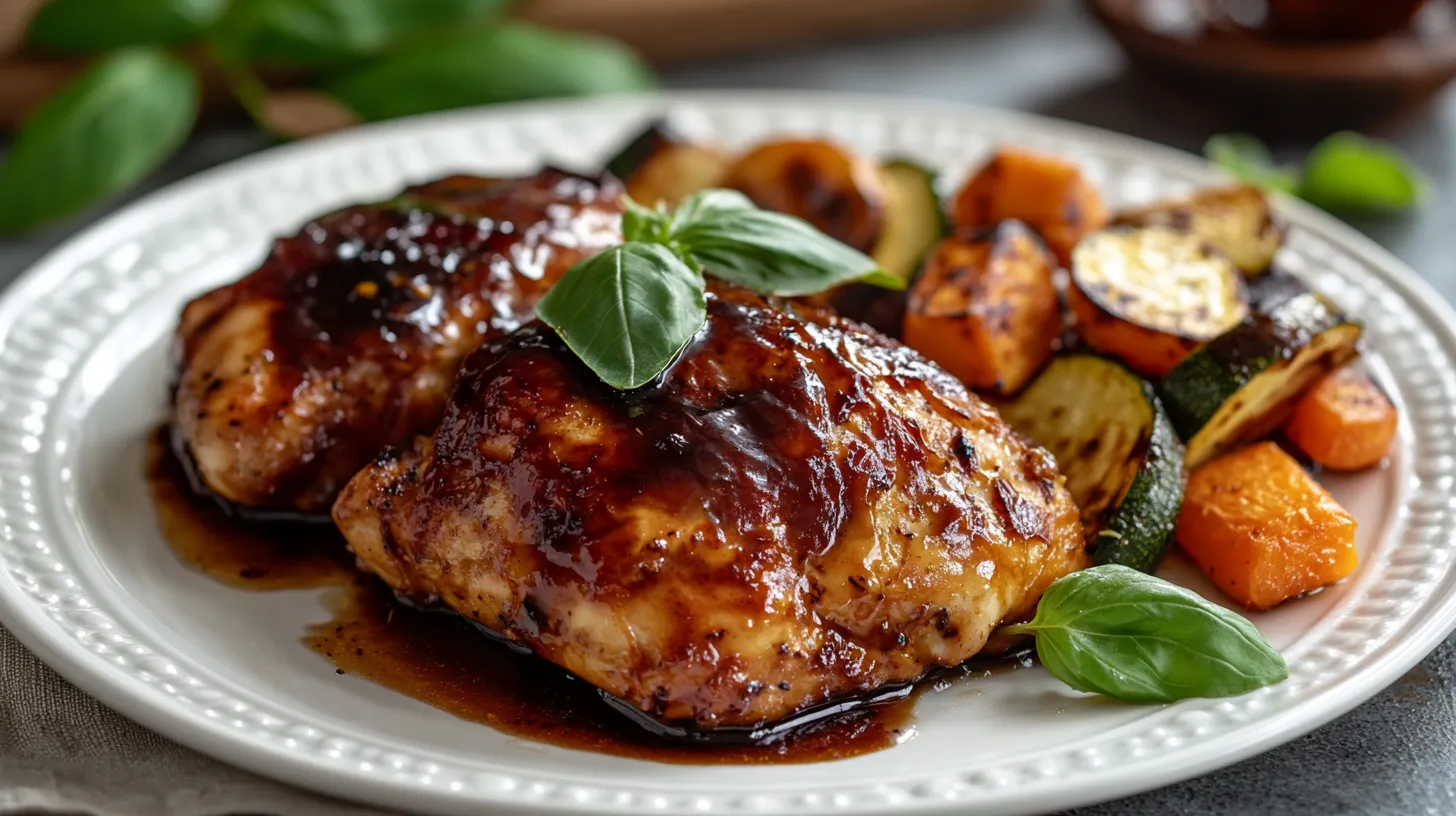When it comes to quick, flavorful meals that feel fancy enough for a dinner party yet simple enough for a weeknight dinner, balsamic chicken is a winner. With its irresistible blend of sweet, tangy, and savory flavors, this dish captures the best of culinary balance. Ready to make the perfect balsamic chicken recipe? Let’s dive in!
Table of contents
- Introduction to Balsamic Chicken Recipe
- Benefits of Cooking Balsamic Chicken at Home
- Essential Ingredients for Balsamic Chicken
- Step-by-Step Process to Make Balsamic Chicken
- Top Variations of Balsamic Chicken Recipe
- Common Mistakes When Cooking Balsamic Chicken
- Pro Tips for the Perfect Balsamic Chicken
- Nutritional Benefits of Balsamic Chicken
- Beginner-Friendly Balsamic Chicken Recipe to Try
- Advanced Techniques for Expert Cooks
- What to Serve with Balsamic Chicken Recipe
- Frequently Asked Questions
- Final Thoughts
Introduction to Balsamic Chicken Recipe
What Makes Balsamic Chicken Unique?
What’s so special about balsamic chicken, you ask? Well, it’s the harmonious dance between the rich tanginess of balsamic vinegar and the natural savoriness of chicken. Think of it as a symphony where each ingredient plays its part, creating a melody of flavors in every bite.
The thick glaze that forms when balsamic vinegar reduces during cooking is like magic. It clings to the chicken, giving it a glossy finish and an intense flavor punch. It’s simple yet sophisticated a true show-stopper on any dinner table.
The History and Popularity of Balsamic Chicken
Balsamic chicken owes its roots to Italian cuisine, where balsamic vinegar, a staple ingredient, shines in countless recipes. The deep, caramelized flavor of aged balsamic vinegar adds depth to simple dishes, making it a favorite in kitchens worldwide. Over the years, balsamic chicken has become a global favorite, cherished for its versatility and ability to please even the pickiest eaters.
Benefits of Cooking Balsamic Chicken at Home
A Healthy and Delicious Meal Option
Cooking balsamic chicken at home isn’t just satisfying it’s a fantastic way to stay on track with healthy eating. With lean chicken as the star ingredient and a naturally low-calorie balsamic glaze, this dish delivers protein and flavor without the guilt.
Cost-Effectiveness of Home-Cooked Meals
Who needs to spend a fortune at fancy restaurants when you can whip up restaurant-quality balsamic chicken in your own kitchen? By cooking at home, you control the quality of your ingredients and save money while enjoying a gourmet experience.

Essential Ingredients for Balsamic Chicken
A perfect balsamic chicken recipe is all about high-quality ingredients. Let’s dive into the essential ingredients that bring this dish to life.
| Ingredient | Quantity |
|---|---|
| Chicken Breasts | 4 pieces (boneless/skinless) |
| Balsamic Vinegar | 1/2 cup |
| Garlic | 3 cloves (minced) |
| Honey or Maple Syrup | 2 tablespoons |
| Olive Oil | 2 tablespoons |
| Fresh Thyme or Basil | 2 teaspoons (optional) |
| Salt | To taste |
| Black Pepper | To taste |
The Role of Balsamic Vinegar in the Recipe
Balsamic vinegar is the soul of this dish. Its deep, tangy flavor paired with its natural sweetness brings the whole recipe to life. For the best results, use a high-quality aged balsamic vinegar. Trust me it’s worth the splurge!
Choosing Between Chicken Breasts, Thighs, or Drumsticks
While chicken breasts are the most commonly used cut for this recipe, chicken thighs are just as delightful! They’re juicier and more forgiving if you accidentally overcook them. You can even use drumsticks if you prefer dark meat. The choice is yours!
Step-by-Step Process to Make Balsamic Chicken
Cooking balsamic chicken is as easy as it is rewarding. Follow these steps, and you’ll have a dish that looks and tastes like it was prepared by a professional chef.
Preparing the Ingredients the Right Way
First, gather your ingredients. Make sure your chicken is patted dry with a paper towel to help it brown better. Mince your garlic and have all your ingredients ready to go. Preparation is half the battle in cooking!
How to Perfectly Marinate the Chicken
Marination is where the magic begins. Combine balsamic vinegar, olive oil, garlic, honey, salt, and pepper in a bowl. Add the chicken and coat it evenly. Let it marinate for at least 30 minutes (or up to 4 hours for maximum flavor).
Pro Tip: Pierce the chicken lightly with a fork before marinating. This helps the marinade penetrate deeper for juicier, more flavorful chicken.
Cooking Methods: Stovetop, Oven, or Grill
There are a few ways to cook balsamic chicken, depending on your preference and available equipment:
- Stovetop: Warm a skillet with olive oil over medium heat. Cook the marinated chicken on both sides until it develops a golden-brown sear. Add the remaining marinade and let it reduce into a thick glaze.
- Oven: Place the marinated chicken in a baking dish and pour the marinade on top. Bake at 375°F (190°C) for 20-25 minutes or until cooked through.
- Grill: For a smoky flavor, grill the chicken over medium heat, basting it with the marinade occasionally.
Top Variations of Balsamic Chicken Recipe
Feeling adventurous? Try these fun variations to switch things up:
Balsamic Chicken with Honey and Mustard
Add 1 tablespoon of Dijon mustard to the marinade for a tangy twist. The honey-mustard combination adds complexity to the dish.
Balsamic Chicken with Roasted Vegetables
Throw in your favorite veggies zucchini, cherry tomatoes, or bell peppers into the baking dish for a one-pan meal. The veggies soak up the marinade, making them irresistibly tasty.
Grilled Balsamic Chicken with Citrus Glaze
Mix in a splash of orange juice with the balsamic vinegar to add a refreshing citrus kick. Perfect for summer grilling!
Common Mistakes When Cooking Balsamic Chicken
Even the best cooks make mistakes! Here’s how to avoid common pitfalls:
Using the Wrong Vinegar
Not all balsamic vinegar is created equal. Avoid using cheap, watery varieties, as they won’t create that rich glaze. Go for aged balsamic with a thicker consistency.
Overcooking or Undercooking the Chicken
Chicken that is overcooked turns out dry, while undercooked chicken poses a safety risk. Use a meat thermometer to ensure the chicken reaches an internal temperature of 165°F (74°C).
Skipping the Marination Process
Marination is essential for tender and flavorful chicken. Don’t rush this step! It’s worth the wait.

Pro Tips for the Perfect Balsamic Chicken
Cooking balsamic chicken is simple, but there are a few tricks to elevate it from good to absolutely unforgettable. Here are some expert tips to help you nail it every single time:
Choosing Seasonal Ingredients for Freshness
Want to enhance the flavor of your balsamic chicken? Use seasonal, fresh ingredients! For example, during summer, add fresh basil or serve the dish with juicy cherry tomatoes. In winter, toss in some caramelized onions or roasted root vegetables. Seasonal ingredients bring a fresh, vibrant quality to the dish that no store-bought seasoning can replicate.
Balancing Sweet and Tangy Flavors
Getting the balance of flavors right is the key to a good balsamic chicken recipe. Balsamic vinegar is tangy, so it needs sweetness to mellow it out. Honey or maple syrup is a natural choice, but don’t overdo it you don’t want it to taste like dessert. Add the sweetness in small increments and taste as you go.
A pinch of salt and a dash of black pepper can also help balance the flavors. Think of your kitchen as a science lab; small adjustments can make a huge difference.
How to Create a Restaurant-Quality Presentation
Want your balsamic chicken to look as good as it tastes? Plate it like a pro. Slice the chicken diagonally for an elegant presentation. Drizzle the balsamic glaze over the chicken and let it flow onto the plate for an artistic touch. Garnish with fresh herbs like thyme or basil, and add a side of roasted vegetables or salad for a pop of color.
Nutritional Benefits of Balsamic Chicken
One of the many reasons balsamic chicken is so popular is because it’s not just delicious it’s healthy too! Let’s break down the nutritional benefits:
| Nutrient | Per Serving (Approx.) |
|---|---|
| Calories | 230-300 |
| Protein | 25-30 grams |
| Fat | 7-10 grams |
| Carbohydrates | 8-12 grams |
| Fiber | 1-2 grams |
| Sugar | 6-8 grams |
| Sodium | 400-500 mg |
Why Chicken is a Great Protein Source
Chicken is lean, high in protein, and low in saturated fat. It’s a powerhouse of nutrition, providing essential amino acids that help build muscle and repair tissues. Plus, it’s incredibly versatile, making it a great option for healthy meals like balsamic chicken.
The Health Benefits of Balsamic Vinegar
Balsamic vinegar isn’t just tasty it’s packed with antioxidants, which help combat free radicals in your body. It can also aid in digestion and regulate blood sugar levels. Low in calories and free of fat, balsamic vinegar adds a burst of flavor without the guilt.
A Low-Calorie and Guilt-Free Meal Option
If you’re watching your calorie intake, balsamic chicken is an excellent choice. With most of the flavor coming from the balsamic glaze and herbs, this dish is naturally light without compromising on taste. Serve it with steamed vegetables or quinoa for a well-rounded, low-calorie meal.
Beginner-Friendly Balsamic Chicken Recipe to Try
Here’s a quick and easy balsamic chicken recipe for beginners. Follow these steps, and you’ll have a delicious dish in no time.
Ingredients:
| Ingredient | Quantity |
|---|---|
| Chicken Breasts | 4 pieces |
| Balsamic Vinegar | 1/2 cup |
| Olive Oil | 2 tablespoons |
| Honey | 2 tablespoons |
| Garlic | 3 cloves, minced |
| Salt and Pepper | To taste |
| Fresh Basil (Optional) | For garnish |
Simple Instructions:
- In a bowl, whisk together balsamic vinegar, olive oil, honey, garlic, salt, and pepper.
- Add the chicken breasts to the marinade, ensuring they’re evenly coated. Cover and chill in the refrigerator for 30 minutes to 4 hours.
- Warm a skillet over medium heat and lightly coat it with olive oil. Sear the chicken breasts on both sides until golden brown (about 3-4 minutes per side).
- Pour the remaining marinade into the skillet and reduce the heat to low. Let it simmer until the chicken is fully cooked (internal temperature: 165°F) and the sauce thickens into a glaze.
- Serve hot, garnished with fresh basil, and enjoy!
Advanced Techniques for Expert Cooks
If you’re ready to go beyond the basics, try these advanced techniques to elevate your balsamic chicken recipe:
How to Create a Balsamic Reduction Sauce
A balsamic reduction sauce is the ultimate finishing touch for this dish. Simmer balsamic vinegar with a hint of honey until it reduces by half. The result? A thick, glossy sauce that’s perfect for drizzling.
Infusing Additional Flavors with Wine or Stock
For a more complex flavor profile, deglaze the skillet with white wine or chicken stock after searing the chicken. Let it reduce before adding the marinade. This step adds depth to the dish.
Sous Vide Balsamic Chicken for Ultimate Tenderness
If you have a sous vide machine, use it! Vacuum-seal the marinated chicken and cook it at 150°F (65°C) for 1.5 hours. Sear the chicken in a hot skillet for that perfect golden crust.
What to Serve with Balsamic Chicken Recipe
- Roasted Brussels Sprouts & Cauliflower Hash Browns: A crispy and flavorful low-carb side.
- Caramel Frappuccino Recipe: A sweet and creamy drink pairing.
- Chicken and Shrimp Recipes: A protein-packed side dish for extra flavor.
- Beef Heart Recipe: A rich, iron-packed dish that adds an adventurous protein option to your meal.
Frequently Asked Questions
How Long Should I Marinate the Chicken?
For the best results, marinate the chicken for at least 30 minutes, but if you have time, aim for 2-4 hours. The longer the chicken marinates, the more flavorful it becomes. Avoid marinating for more than 24 hours, as the acidity in the balsamic vinegar can start breaking down the chicken’s texture.
Can I Use Other Meats or Vegetarian Alternatives?
Absolutely! While chicken is the star of this recipe, you can easily substitute it with other proteins. Pork tenderloin or salmon works wonderfully with balsamic glaze. If you’re vegetarian, try balsamic tofu or roasted portobello mushrooms they soak up the flavors beautifully.
What’s the Best Way to Store Leftovers?
Keep leftover balsamic chicken in an airtight container in the fridge for up to 3-4 days. To reheat, use a skillet over medium heat and add a splash of water or chicken stock to keep the chicken moist.
Can I Make Balsamic Chicken Ahead of Time?
Yes, balsamic chicken is perfect for meal prep. Cook the chicken and let it cool completely before storing it in the fridge. When it’s time to serve, warm it up gently on the stovetop or in the oven.
Final Thoughts
Balsamic chicken isn’t just a recipe it’s a celebration of simple, bold flavors that anyone can master. Whether you’re a beginner trying your hand at cooking or an experienced foodie experimenting with advanced techniques, this dish has something for everyone.
So, why not give it a try tonight? Your taste buds will thank you. And remember, cooking is all about enjoying the process, experimenting with flavors, and creating something truly special. Happy cooking!

Balsamic Chicken
Equipment
- Skillet
- Mixing Bowl
Ingredients
Balsamic Chicken Marinade
- 4 pieces chicken breasts boneless, skinless
- 1/2 cup balsamic vinegar
- 3 cloves garlic minced
- 2 tablespoons honey or maple syrup
- 2 tablespoons olive oil
- 2 teaspoons fresh thyme or basil optional
- salt to taste
- black pepper to taste
Instructions
- In a bowl, whisk together balsamic vinegar, olive oil, honey, garlic, salt, and pepper.
- Add the chicken breasts to the marinade, ensuring they are evenly coated. Cover and refrigerate for at least 30 minutes or up to 4 hours.
- Heat a skillet over medium heat and lightly coat it with olive oil. Sear the chicken on both sides until golden brown, about 3-4 minutes per side.
- Pour the remaining marinade into the skillet and reduce the heat to low. Let it simmer until the chicken is fully cooked (internal temperature: 165°F) and the sauce thickens into a glaze.
- Serve hot, garnished with fresh basil or thyme, and enjoy!
